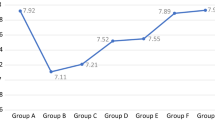Abstract
Clubfoot is the commonest congenital deformity in babies. More than 100,000 babies are born worldwide each year with congenital clubfoot. Around 80% of the cases occur in developing nations. We treated 154 feet [mean Pirani score (total) 5.57] in 96 children (78 males, 18 females) by the Ponseti method from January 2003 to December 2005. A prospective follow-up for a mean duration of 19.5 months (range 6–32 months) was undertaken. After six months of treatment the Pirani score was reduced to zero for all patients. The results show that corrective surgery, sometimes multiple, can be avoided in most cases which are usually associated with the development of a stiff, painful foot. Low socio-economic status and illiteracy prevailing in developing nations increases the prevalence of neglected clubfoot that is still harder to correct. Integration into various programs and proper use of available resources can decrease neglected clubfoot and improve chances of successful and timely correction of deformity. Bracing constitutes an important part of treatment and proper motivation and education of the parents mitigates the chances of losing correction. The Ponseti method of correcting clubfoot is especially important in developing countries, where operative facilities are not available in the remote areas and well-trained physicians and personnel can manage the cases effectively with cast treatment only.
Résumé
Le pied bot est parmi les déformations les plus habituelles chez l’enfant. Plus de 100.000 enfants naissent chaque année avec un pied bot congénital. 80% des cas proviennent des pays en voie de développement. Nous avons traité 150 cas de pieds avec un score de Pirani moyen de 5.57 chez 96 enfants. 78 étaient de sexe masculin, 18 de sexe féminin. Nous avons utilisé la méthode de Ponseti de janvier 2003 à décembre 2005. Une étude prospective a été réalisée sur une période de 19,5 mois (6 à 32 mois). Après six mois de traitement, le score de Pirani a été réduit à 0 chez tous les patients. Le résultat montre qu’une correction chirurgicale peut être parfois nécessaire dans les cas présentant un pied raide et très douloureux. L’utilisation de toutes les ressources nécessaires permettent de diminuer le nombre de pieds bots négligés et d’améliorer les chances de succès du traitement de cette déformation. Le traitement orthopédique est une part importante du traitement et la motivation et l’éducation des parents augmentent les chances de succès et diminuent les pertes de correction. La méthode de Ponseti est très importante dans les pays en voie de développement (80%) où les conditions opératoires ne sont pas très faciles et nécessitent un personnel entraîné.
Similar content being viewed by others
References
Brand RA, Laaveg SJ, Crowninshield RD, Ponseti IV (1981) The center of pressure path in treated clubfoot. Clin Orthop Relat Res 160:43–47
Colburn M, Williams M (2003) Evaluation of the treatment of idiopathic clubfoot by using the Ponseti method. J Foot Ankle Surg 42(5):259–267
Cooper DM, Dietz FR (1995) Treatment of idiopathic clubfoot: a thirty-year follow-up note. J Bone Joint Surg Am 77(10):1477–1489
Cowell HR, Wein BK (1980) Genetic aspect of clubfoot. J Bone Joint Surg Am 62(8):1381–1384
Dobbs MB, Gordon JE, Walton T, Schoenecker P (2004) Bleeding complications following percutaneous tendoachilles tenotomy in the treatment of clubfoot deformity. J Pediatr Orthop 24(4):353–357
Herzenberg JE, Radler C, Bor N (2002) Ponseti versus traditional methods of casting for idiopathic clubfoot. J Pediatr Orthop 22(4):517–521
Ippolito E, Farsetti P, Caterini R, Tudisco C (2003) Long-term comparative results in patients with congenital clubfoot treated with two different protocols. J Bone Joint Surg Am 85(7):1286–1294
Laaveg SJ, Ponseti IV (1980) Long-term results of treatment of congenital clubfoot. J Bone Joint Surg Am 62(1):23–31
Morcuende JA, Abbasi D, Dolan LA, Ponseti IV (2005) Results of an accelerated Ponseti protocol for clubfoot. J Pediatr Orthop 25(5):623–626
Morcuende JA, Dolan LA, Dietz FR, Ponseti IV (2004) Radical reduction in the rate of extensive corrective surgery for clubfoot using the Ponseti method. Pediatrics 113(2):376–380
Palmer RM (1964) Genetics of talipes equinus varus. J Bone Joint Surg Am 46:542–556
Ponseti IV, Smoley EN (1963) Congenital clubfoot: the results of treatment. J Bone Joint Surg Am 45(2):2261–2275
Ponseti IV (1992) Treatment of congenital clubfoot. J Bone Joint Surg Am 74(3):448–454
Ponseti IV (1994) The treatment of congenital clubfoot. J Orthop Sports Phys Ther 20(1):1
Ponseti IV (1998) Correction of the talar neck angle in congenital clubfoot with sequential manipulation and casting. Iowa Orthop J 18:74–75
Ponseti IV (2000) Clubfoot management. J Pediatr Orthop 20(6):699–700
Scher DM, Feldman DS, Van Bosse HJ, Sala DA, Lehman WB (2004) Predicting the need for tenotomy in the Ponseti method for correction of clubfeet. J Pediatr Orthop 24(4):349–352
Thacker MM, Scher DM, Sala DA, Van Bosse HJ, Feldman DS, Lehman WB (2005) Use of the foot abduction orthosis following ponseti casts: is it essential? J Pediatr Orthop 25(2):225–228
Yamamoto H (1979) A clinical, genetic and epidemiologic study of congenital clubfoot. Jinrui Idengaku Zasshi 24(1):37–44
Author information
Authors and Affiliations
Corresponding author
Rights and permissions
About this article
Cite this article
Gupta, A., Singh, S., Patel, P. et al. Evaluation of the utility of the Ponseti method of correction of clubfoot deformity in a developing nation. International Orthopaedics (SICO 32, 75–79 (2008). https://doi.org/10.1007/s00264-006-0284-7
Received:
Revised:
Accepted:
Published:
Issue Date:
DOI: https://doi.org/10.1007/s00264-006-0284-7




